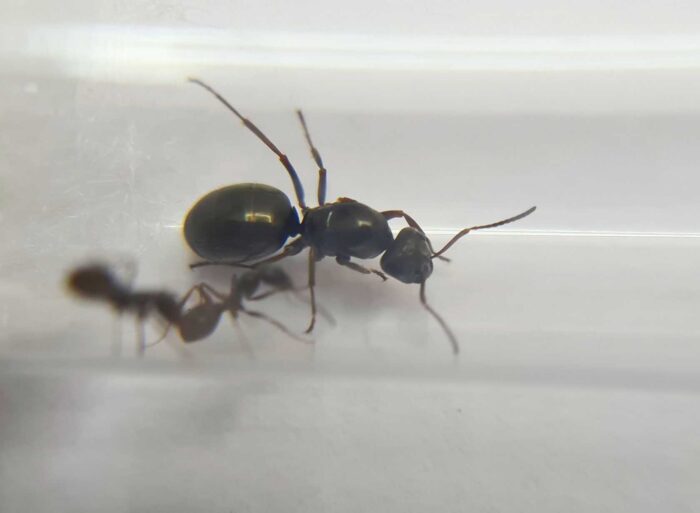Formica lemani
49,90 zł – 139,90 zł
Worldwide shipping
Free delivery over 999 PLN
The highest quality of goods
Live delivery guarantee
24/7 Personal Support
Fair Prices
Description
The Formica lemani colony is monogynous and can have up to 10,000 workers. They have a medium development rate. The queen is 8-10mm in size, while the workers are 4-7 mm. They are uniformly black or brown in color. They feed on food insects, syrup, fruit, vegetables, jelly, and cooked chicken without salt.
Additional information
| Behavior | |
|---|---|
| Difficulty in breeding | |
| Origin | |
| The size of ants | |
| Wintering |
Formica lemani – An Incredible Species
If you’re a lover of ants, then you’re in for a treat with Formica lemani. This remarkable species is known for its unique characteristics and fascinating behaviors. In this comprehensive product description, we will delve into the details of this ant species and provide you with all the information you need to understand and appreciate Formica lemani.
Colony Type and Size
- Colony Type: Monogyny
- Colony Size: Up to 10,000 workers
- Development speed: medium
Size and Color:
- Queen: 8-10 mm
- Workers: 4-7 mm
The ants’ coloration is uniformly black or brown.
Nutrition
- Food insects (such as cockroaches and crickets) dead, or live if colony is big
- Syrup (a mixture of water and honey or sugar, with a ratio of 4/3 water:1)
- Fruits and vegetables
- Jelly
- Cooked chicken without salt, shrimps
- Honey
Don’t forget to check out our food products to ensure a well-balanced diet for your colony!
Humidity and Temperature Requirements
- Arena Humidity: 30 – 50%
- Nest Humidity: 50 – 60%
- Arena Temperature: 22 – 28 °C
- Nest Temperature: 21 – 24 °C
To ensure the well-being and thriving of Formica lemani, it is vital to maintain suitable humidity and temperature levels. In the arena or foraging area, the humidity should be maintained at a range of 30-50%. Inside the nest, the humidity should be slightly higher, between 50-60%. As for the temperature, the arena should be kept between 22-28 °C, while the nest itself should be slightly cooler, ranging from 21-24 °C.
Special Characteristics and Preferences
Formica lemani is an extraordinary species with unique behavior and preferences. One of the most intriguing aspects is their ability to collect honeydew from aphid colonies. They have a mutually beneficial relationship with aphids, feeding on the sweet substance produced by these tiny insects. This behavior showcases the ants’ resourcefulness and intelligence in finding food sources.
When it comes to nesting, Formica lemani shows adaptability to various materials. Recommended options for breeding nests include acrylic, gypsum, aerated concrete, earth, and cork. These materials provide suitable conditions for the colony’s growth and development, ensuring a thriving and healthy ant community.
Why Choose Formica lemani?
Now that you have gained insights into the characteristics and preferences of Formica lemani, you might be wondering why choosing them as your ant species of choice is a great decision. Here are some compelling reasons:
Fascinating Behavior
Formica lemani is known for its fascinating behavior, particularly their collection of honeydew from aphid colonies. Observing this behavior can be a captivating and educational experience, providing insight into the complex relationships between different species in nature.
Low Maintenance
Formica lemani is a species that requires relatively low maintenance compared to other ant species. Their dietary preferences and nesting adaptability mean that it’s easier to provide them with suitable living conditions and meet their nutritional needs. This makes them a perfect choice for ant lovers of all experience levels.
Beautiful and Diverse
The uniform black or brown coloration of Formica lemani adds to its appeal. Watching these ants go about their daily tasks in their uniquely structured colonies can surely bring joy and awe to any onlooker.
Educational Value
Formica lemani provides an excellent opportunity for educational purposes. They can be used in classrooms or educational settings to teach children and adults alike about the complexities of the natural world and the interconnectedness of different organisms.
Rewarding Hobby
Keeping Formica lemani as a pet or hobby can be highly rewarding. The process of setting up a suitable habitat, observing the colony’s growth, and creating a thriving ant community can bring a sense of accomplishment and fulfillment.
Conclusion
Formica lemani is undoubtedly a remarkable ant species worth considering for ant enthusiasts. Their unique characteristics, intriguing behaviors, and adaptability make them a captivating addition to any ant collection. Whether you’re new to ant-keeping or a seasoned ant enthusiast, Formica lemani is sure to amaze and fascinate you with their intricate world. So why wait? Start your journey with Formica lemani today and embark on a new and exciting ant-keeping adventure.













There are no reviews yet.